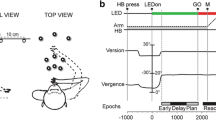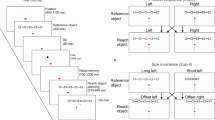Abstract
Neurophysiological studies suggest that the transformation of visual signals into arm movement commands does not involve a sequential recruitment of the various reach-related regions of the cerebral cortex but a largely simultaneous activation of these areas, which form a distributed and recurrent visuomotor network. However, little is known about how the reference frames used to encode reach-related variables in a given “node” of this network vary with the time taken to generate a behavioral response. Here we show that in an instructed delay reaching task, the reference frames used to encode target location in the parietal reach region (PRR) and area 5 of the posterior parietal cortex (PPC) do not evolve dynamically in time; rather the same spatial representation exists within each area from the time target-related information is first instantiated in the network until the moment of movement execution. As previously reported, target location was encoded predominantly in eye coordinates in PRR and in both eye and hand coordinates in area 5. Thus, the different computational stages of the visuomotor transformation for reaching appear to coexist simultaneously in the parietal cortex, which may facilitate the rapid adjustment of trajectories that are a hallmark of skilled reaching behavior.








Similar content being viewed by others
References
Batista AP, Buneo CA, Snyder LH, Andersen RA (1999) Reach plans in eye-centered coordinates. Science 285:257–260
Battaglia-Mayer A, Ferraina S, Mitsuda T, Marconi B, Genovesio A, Onorati P, Lacquaniti F, Caminiti R (2000) Early coding of reaching in the parietooccipital cortex. J Neurophysiol 83:2374–2391
Battaglia-Mayer A, Ferraina S, Genovesio A, Marconi B, Squatrito S, Molinari M, Lacquaniti F, Caminiti R (2001) Eye-hand coordination during reaching. II. An analysis of the relationships between visuomanual signals in parietal cortex and parieto-frontal association projections. Cereb Cortex 11:528–544
Buneo CA, Andersen RA (2006) The posterior parietal cortex: sensorimotor interface for the planning and online control of visually guided movements. Neuropsychologia 44:2594–2606
Buneo CA, Jarvis MR, Batista AP, Andersen RA (2002) Direct visuomotor transformations for reaching. Nature 416:632–636
Buneo CA, Jarvis MR, Batista AP, Andersen RA (2003) Properties of spike train spectra in two parietal reach areas. Exp Brain Res 153:134–139
Burnod Y, Baraduc P, Battaglia-Mayer A, Guigon E, Koechlin E, Ferraina S, Lacquaniti F, Caminiti R (1999) Parieto-frontal coding of reaching: an integrated framework. Exp Brain Res 129:325–346
Caminiti R, Ferraina S, Mayer AB (1998) Visuomotor transformations: early cortical mechanisms of reaching. Curr Opin Neurobiol 8:753–761
Crawford JD, Medendorp WP, Marotta JJ (2004) Spatial transformations for eye-hand coordination. J Neurophysiol 92:10–19
Deneve S, Latham PE, Pouget A (2001) Efficient computation and cue integration with noisy population codes. Nat Neurosci 4:826–831
Efron B, Tibshirani RJ (1993) An introduction to the bootstrap. Chapman and Hall, London
Flanders M, Helms-Tillery SI, Soechting JF (1992) Early stages in a sensorimotor transformation. Behav Brain Sci 15:309–362
Flanders M, Hondzinski JM, Soechting JF, Jackson JC (2003) Using arm configuration to learn the effects of gyroscopes and other devices. J Neurophysiol 89:450–459
Henriques DY, Klier EM, Smith MA, Lowy D, Crawford JD (1998) Gaze-centered remapping of remembered visual space in an open-loop pointing task. J Neurosci 18:1583–1594
Kalaska JF, Crammond DJ (1995) Deciding not to go—neuronal correlates of response selection in a go/nogo task in primate premotor and parietal cortex. Cereb Cortex 5:410–428
McIntyre J, Stratta F, Lacquaniti F (1998) Short-term memory for reaching to visual targets: psychophysical evidence for body-centered reference frames. The J Neurosci 18:8423–8435
Messier J, Kalaska JF (2000) Covariation of primate dorsal premotor cell activity with direction and amplitude during a memorized-delay reaching task. J Neurophysiol 84:152–165
Russo GS, Backus DA, Ye SP, Crutcher MD (2002) Neural activity in monkey dorsal and ventral cingulate motor areas: comparison with the supplementary motor area. J Neurophysiol 88:2612–2629
Salinas E, Abbott LF (1995) Transfer of coded information from sensory to motor networks. J Neurosci 15:6461–6474
Shen LM, Alexander GE (1997) Neural correlates of a spatial sensory-to-motor transformation in primary motor cortex. J Neurophysiol 77:1171–1194
Smith MA, Crawford JD (2001) Self-organizing task modules and explicit coordinate systems in a neural network model for 3-D saccades. J Comput Neurosci 10:127–150
Snyder LH, Batista AP, Andersen RA (1997) Coding of intention in the posterior parietal cortex. Nature 386:167–170
Snyder LH, Batista AP, Andersen RA (2000) Intention-related activity in the posterior parietal cortex: a review. Vision Res 40:1433–1441
Wise SP, Boussaoud D, Johnson PB, Caminiti R (1997) Premotor and parietal cortex: corticocortical connectivity and combinatorial computations. Annu Rev Neurosci 20:25–42
Xing J, Andersen RA (2000) Models of the posterior parietal cortex which perform multimodal integration and represent space in several coordinate frames. J Cogn Neurosci 12:601–614
Zar JH (1996) Biostatistical Analysis. Prentice Hall, NJ
Zipser D, Andersen RA (1988) A back-propagation programmed network that simulates response properties of a subset of posterior parietal neurons. Nature 331:679–684
Acknowledgments
The authors wish to thank Betty Gillikin, Kelsie Pejsa, Lea Martel and Viktor Shcherbatyuk for technical assistance, Janet Baer and Janna Wynne for veterinary care and Cierina Marks and Tessa Yao for administrative assistance. This work was supported by the J. G. Boswell Foundation, the Sloan-Swartz Center for Theoretical Neurobiology, the National Eye Institute (NEI), the Defense Advanced Research Projects Agency (DARPA), and the Office of Naval Research (ONR).
Author information
Authors and Affiliations
Corresponding author
Rights and permissions
About this article
Cite this article
Buneo, C.A., Batista, A.P., Jarvis, M.R. et al. Time-invariant reference frames for parietal reach activity. Exp Brain Res 188, 77–89 (2008). https://doi.org/10.1007/s00221-008-1340-x
Received:
Accepted:
Published:
Issue Date:
DOI: https://doi.org/10.1007/s00221-008-1340-x




